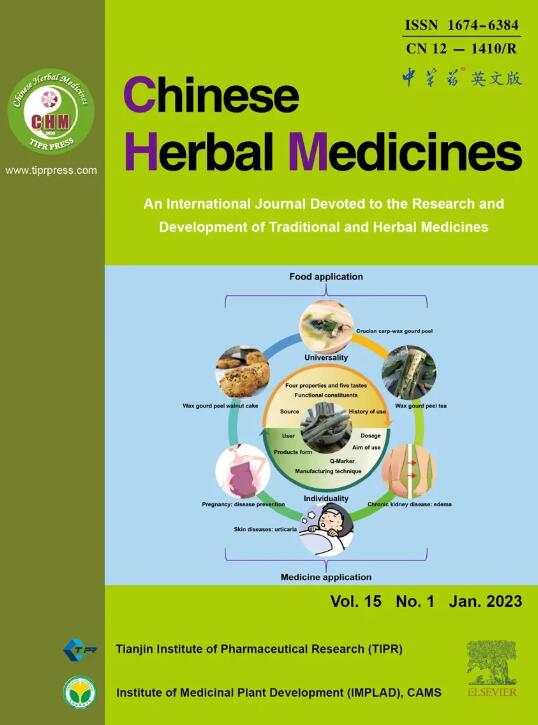虎蹄草提取物通过PI3K/JNK/P38信号通路及调节脂质稳态抑制ova致敏性过敏性哮喘
IF 8.9
4区 医学
Q1 CHEMISTRY, MEDICINAL
引用次数: 0
摘要
目的探讨虎蹄草的作用及作用机制。蛋清蛋白(OVA)诱导的过敏性哮喘。方法采用超高效液相色谱-四极杆飞行时间质谱法对HCE进行成分鉴定。用OVA致敏小鼠建立哮喘模型,以地塞米松为阳性对照。观察呼吸反应性、支气管肺泡灌洗液及外周血白细胞计数、血清及肺组织细胞因子水平测定及组织学检查,评价HCE对哮喘的治疗效果。采用网络药理学方法进行机制预测。应用Western blotting和非靶向脂质组学方法进行机制验证。结果鉴定出52种化合物,以萜类化合物和黄酮类化合物为主。HCE显著降低气道阻力、肺组织嗜酸性粒细胞浸润及免疫球蛋白E、白细胞介素-4、白细胞介素-5、白细胞介素-13水平。网络药理学分析提示,磷脂酰肌醇3-激酶(PI3K)、c-Jun n末端激酶(JNK)和p38丝裂原活化蛋白激酶(p38 MAPK)可能是HCE治疗过敏性哮喘的关键蛋白。Western blot结果显示,hce处理组磷酸化PI3K、JNK、P38水平下调。此外,HCE显著上调神经酰胺和鞘磷脂水平,下调磷脂酰胆碱水平。结论hce通过PI3K/JNK/P38信号通路及调节脂质稳态抑制变应性哮喘。本文章由计算机程序翻译,如有差异,请以英文原文为准。
Hyssopus cuspidatus extract inhibited OVA-sensitized allergic asthma through PI3K/JNK/P38 signaling pathway and lipid homeostasis regulation
Objective
To investigate the effect and mechanism of Hyssopus cuspidatus Boriss. extract (HCE) in ovalbumin (OVA)-induced allergic asthma.
Methods
Components identification of HCE was conducted using ultra performance liquid chromatography-quadrupole-time of flight-mass spectrometry. Mice were sensitized with OVA to establish asthmatic model, and dexamethasone was used as positive control. Respiratory reactivity, white cells counting in bronchoalveolar lavage fluid and peripheral blood, cytokine level measurement in serum and lung tissue, and histologic examination were performed to evaluate the therapeutic effect of HCE on asthma. Network pharmacology approach was used for mechanism prediction. Western blotting and untargeted lipidomics method were applied for mechanism validation.
Results
Fifty-two compounds were identified in HCE, predominantly terpenoids and flavonoids. HCE markedly reduced airway resistance, the eosinophil infiltration in lung tissues, and the levels of immunoglobulin E, interleukin-4, interleukin-5, and interleukin-13. Network pharmacology analysis suggested phosphatidylinositol 3-kinases (PI3K), c-Jun N-terminal kinase (JNK), and p38 Mitogen-activated protein kinase (p38 MAPK) may be key proteins of HCE in the treatment of allergic asthma. Western blot results indicated that the levels of phosphorylated PI3K, JNK, and P38 were downregulated in HCE-treated group. Moreover, HCE significantly upregulated the levels of ceramide and sphingomyelin and downregulated the level of phosphatidylcholine.
Conclusion
HCE inhibited allergic asthma via PI3K/JNK/P38 signaling pathway and lipid homeostasis regulation.
求助全文
通过发布文献求助,成功后即可免费获取论文全文。
去求助
来源期刊

Chinese Herbal Medicines
CHEMISTRY, MEDICINAL-
CiteScore
4.40
自引率
5.30%
发文量
629
审稿时长
10 weeks
期刊介绍:
Chinese Herbal Medicines is intended to disseminate the latest developments and research progress in traditional and herbal medical sciences to researchers, practitioners, academics and administrators worldwide in the field of traditional and herbal medicines. The journal's international coverage ensures that research and progress from all regions of the world are widely included.
CHM is a core journal of Chinese science and technology. The journal entered into the ESCI database in 2017, and then was included in PMC, Scopus and other important international search systems. In 2019, CHM was successfully selected for the “China Science and Technology Journal Excellence Action Plan” project, which has markedly improved its international influence and industry popularity. CHM obtained the first impact factor of 3.8 in Journal Citation Reports (JCR) in 2023.
 求助内容:
求助内容: 应助结果提醒方式:
应助结果提醒方式:


